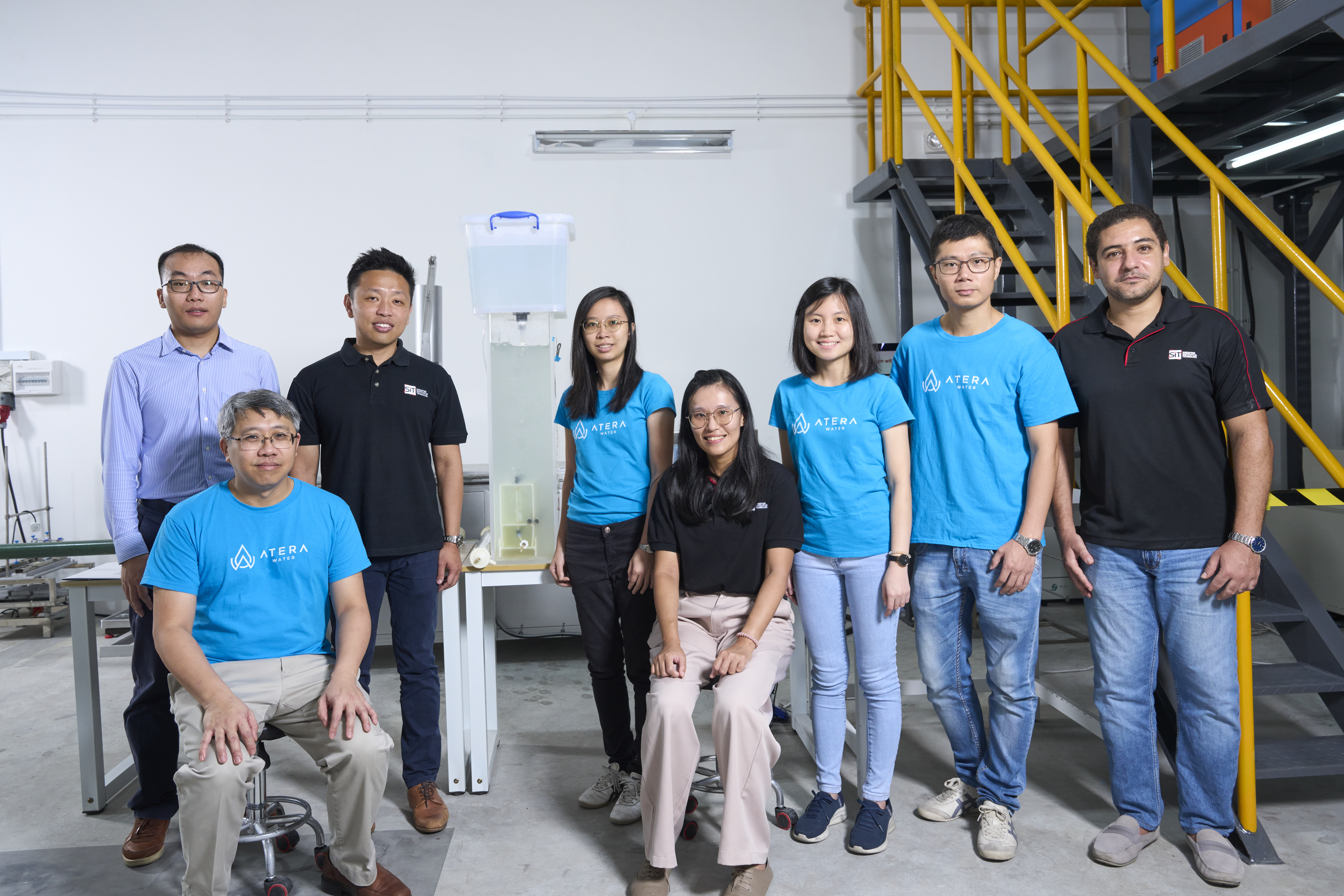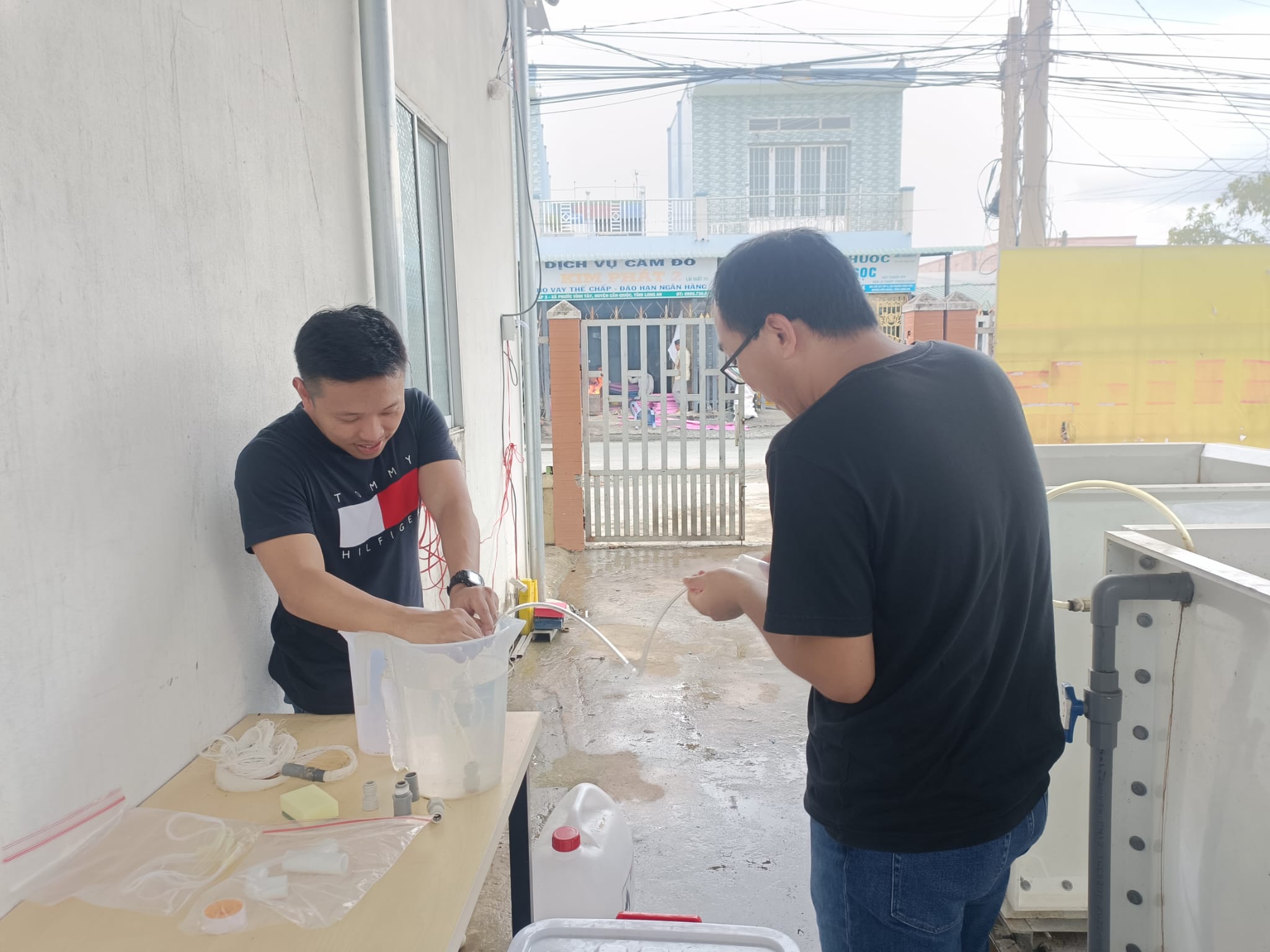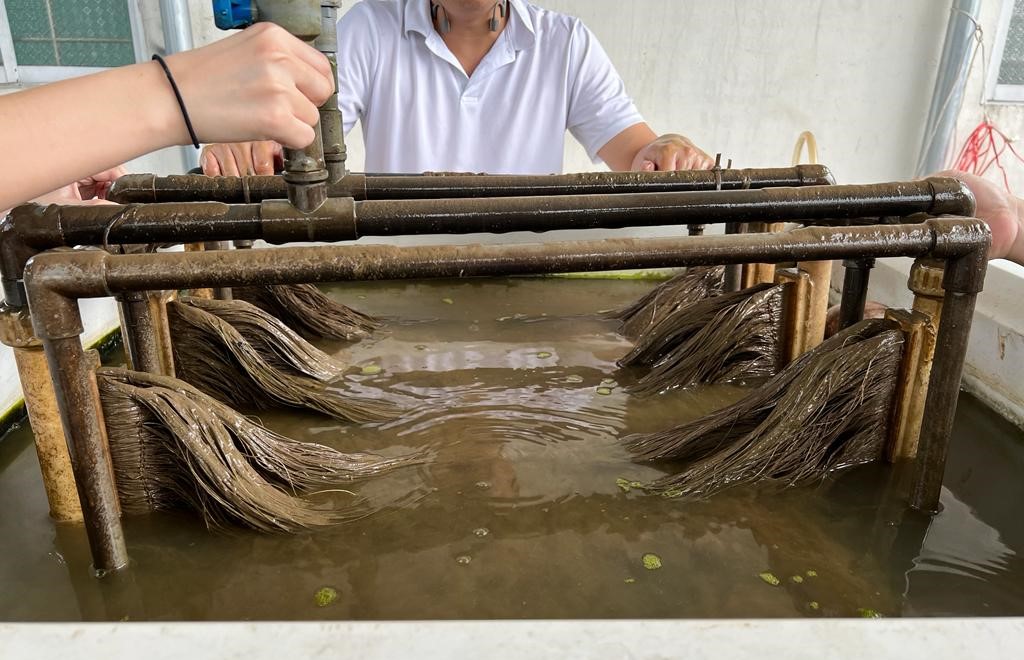Their innovative membrane technology is bringing affordable, advanced water filtration to underserved communities in Southeast Asia.

From left: Associate Professor An Hui, Engineering Cluster, SIT; Dr Adrian Yeo, CEO and Co-Founder, Atera Water; Associate Professor Victor Wang, Engineering Cluster, SIT; Ms Rachel Yap, Product Engineer, Atera Water; Assistant Professor Elisa Ang, Engineering Cluster, SIT; Ms Tai Kee, COO and Co-Founder, Atera Water; Dr Chen Xuelong, Senior Research Scientist, Atera Water; and Dr Peter Beshay, Engineering Cluster, SIT. (SIT Photo: Keng Photography/Tan Eng Keng)
When the Atera Water team first visited Vietnam in 2023 to pilot their new membrane technology, they encountered a sobering reality. The water quality in Vietnam’s rivers was far worse than they had anticipated, with solid concentrations approximately 20 times higher than Singapore’s reservoirs.
“It was a wake-up call for us,” recalled Ms Tai Kee, Atera Water’s co-founder and Chief Operating Officer. “We realised the normal way of running membrane systems in Singapore wouldn’t work there, and the traditional system would be damaged quickly in those conditions.”
With newfound insights into the challenges facing water utilities in developing regions, Atera Water began searching for solutions that could overcome the limitations of conventional membrane systems. That was when they discovered SIT’s research on membrane fouling issues.
The partnership between Atera Water and SIT bore fruit in the TeraStreamTM system the same year. This system incorporates the nanocomposite membrane ClarityTM developed by Professor Hu Xiao of Nanyang Technological University’s School of Materials Science and Engineering and Atera Water. Made from low-cost polymers and reinforced with nanoparticles for higher durability, ClarityTM is stronger and more environmentally friendly than current polyolefin and polyvinylidene fluoride membranes in the market.
“The aim was to bring advanced water treatment technologies to developing countries at a price they could afford,” said Mr Adrian Yeo, co-founder and Chief Executive Officer of Atera Water.
Engineering Around Nature’s Challenges
What sets TeraStreamTM apart is its sophisticated anti-fouling technology, enabling reliable filtration. Traditional membrane filtration systems clog quickly when dealing with water containing high concentrations of solids, a common characteristic of river water in Southeast Asia.
Developed by SIT’s research team, the anti-fouling technology significantly increases the membrane system’s output flux, the rate at which clean water is produced, by removing dirt built up on the membrane surface.

A/Prof Victor Wang (left) and A/Prof An Hui from the SIT research team priming the membrane in preparation for tests at Long An Province, Vietnam. (Photo: Elisa Ang)
“When you filter ‘dirty’ water for too long through a membrane, dirt or deposits will form on the membrane surface, creating fouling that reduces the output flux of clean water,” said Assistant Professor Elisa Ang, who led the SIT team. “Our goal was to excite the water around the membrane to ‘shake’ the membrane to reduce these deposits.”
The team experimented with two main approaches: aeration and water jetting. While aeration – using air bubbles to clean membranes – is a common industry practice, SIT’s innovation lies primarily in its water jetting technique, which has been filed for patent.
“What distinguishes our technology is that we are using the original feed water, which is the dirty water that needs to go into the membrane tank anyway, but directing it in specific ways,” said Asst Prof Ang. “Instead of just filling the tank, we direct the flow so it hits the membrane with sufficient force to dislodge particles or prevent them from settling.”

A closer look at a fouled membrane during a pilot test — a common challenge in conventional water treatment systems. (Photo: Elisa Ang)
Using Computational Fluid Dynamics (CFD) modelling, the team tested numerous configurations to find the optimal setup. This resulted in the membranes being three times less likely to clog during operation, boosting clean water output by at least a 20 per cent increase. This enables the system to treat incoming water with solid content 10 times higher than what conventional membrane systems can handle.
This enhancement means the system can produce more clean water in the same amount of time while using less energy than conventional aeration-only methods. It also extends membrane life and reduces maintenance costs, making the technology viable for long-term deployment.
At least eight SIT students contributed to developing the anti-fouling system, as part of their final-year capstone projects.
“One student developed the CFD model that we use for optimisation, while another set up a validation tank to test the model’s accuracy,” said Asst Prof Ang. “All of them played a part in the project’s success.”
Creating Regional Change
The TeraStreamTM project caught the attention of President Tharman Shanmugaratnam, who cited Atera Water during a dialogue at the Lee Kuan Yew Water Prize 2024 Award Ceremony as an example of a startup innovating to solve global water challenges. Following that, Atera Water invited President Tharman to visit their facilities in August 2024, where the SIT team presented the anti-fouling solution and showcased the students’ contributions.
Building on their success, the SIT-Atera partnership recently secured a Ministry of Education Translational R&D Innovation Fund (MOE-TIF) grant to scale up their work. While the initial project focused on a lab-scale system with a single membrane bundle producing 10 litres of water per day, the grant will fund the development of a demonstration-scale prototype.
“The demonstration plant will feature five to six membrane curtains, producing around 20 cubic metres or 20,000 litres of water daily, enough for about 200 people’s daily water needs,” said Associate Professor Victor Wang, who is part of the SIT research team.
The technology is particularly relevant for utilities and water-intensive industries like textiles, palm oil, and paper manufacturing that draw water directly from rivers. The initial two commercial pilot systems serving such sectors in Malaysia and Vietnam have resulted in cost savings of up to 70 per cent for clients, predominantly due to significant reductions in chemical consumption and toxic sludge production.
Looking ahead, the team plans to expand its reach to Indonesia and the Philippines, with South America and parts of Africa on the horizon.
“Everybody around the world is facing similar challenges in water treatment due to climate change and pollution,” said Ms Tai Kee. “It’s a huge issue because Southeast Asia uses 50 to 70 per cent of river water for their current consumption, so we plan to reach out to all these different clients around the region.”
![[FA] SIT One SITizen Alumni Initiative_Web banner_1244px x 688px.jpg](/sites/default/files/2024-12/%5BFA%5D%20%20SIT%20One%20SITizen%20Alumni%20Initiative_Web%20banner_1244px%20x%20688px.jpg)


